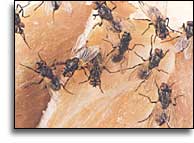HOUSE FLY
|
| DISTRIBUTION |
This insect is cosmopolitan in distribution and is called the house fly because it is very often the fly that occurs most commonly in the home. |
| DESCRIPTION |
 The
house fly is 1/6 to ? inch - 4 to 7,5 mm in length with the female usually
larger than the male. The size of both sexes is dependent to same extent
on the availability of food in larval stage and whether the abdomen is distended
with food. The thorax bears four narrow black stripes and there is a sharp
upward bend in the fourth longitudinal vein. The sexes can be readily separated
by noting the space between the eyes, which in females is almost twice as
broad as in males, or by applying pressure to the abdomen, which results
in the protrusion of an ovipositor in the case of the female. The
house fly is 1/6 to ? inch - 4 to 7,5 mm in length with the female usually
larger than the male. The size of both sexes is dependent to same extent
on the availability of food in larval stage and whether the abdomen is distended
with food. The thorax bears four narrow black stripes and there is a sharp
upward bend in the fourth longitudinal vein. The sexes can be readily separated
by noting the space between the eyes, which in females is almost twice as
broad as in males, or by applying pressure to the abdomen, which results
in the protrusion of an ovipositor in the case of the female. |
| HABITS |
The house fly passes through four stages in its life cycle:
egg, larva or maggot, pupa and adult. The female usually in clusters of 20 - 50
can be seen depositing their eggs on suitable material. The white eggs which
are about 1mm long are laid singly but pile up on small masses. The female
deposits from 75 to 150 eggs during her life time; she may lay five or six
batches at intervals of several days between each batch. All in all, she may
deposit from 350 to 900 eggs and one female has been known to deposit 2,387
in 21 batches. |
| POTENTIAL HAZARDS |
 Although
the house fly is often an unbearable nuisance, we are primarily concerned
with it as a carrier of disease organisms. The house fly feeds on fecal
material, vomit and sputum, after which it might alight on human food. It
is very well adapted in both structure and behavior for the transmission
of a disease. Its body is covered with fine hairs and bristles, which readily
pick up dirt particles. House flies have been shown to carry the disease
organisms causing typhoid fever, cholera, diarrhea, dysentery, anthrax,
etc. as well as parasitic worms. Although
the house fly is often an unbearable nuisance, we are primarily concerned
with it as a carrier of disease organisms. The house fly feeds on fecal
material, vomit and sputum, after which it might alight on human food. It
is very well adapted in both structure and behavior for the transmission
of a disease. Its body is covered with fine hairs and bristles, which readily
pick up dirt particles. House flies have been shown to carry the disease
organisms causing typhoid fever, cholera, diarrhea, dysentery, anthrax,
etc. as well as parasitic worms. |
| PREVENTION |
All outside trash areas must be kept clean. Garbage and trash should be placed in plastic bags before being placed in trash receptacles. By placing trash in bags, odors can be markedly reduced therefore attracting fewer flies.
Whenever flies are found breeding around the building, the breeding source needs to be removed. An example of this is garbage that may fall under a dumpster and is not removed on a regular basis.
A further step in reducing the number of flies near a building is to locate trash receptacles as far from the building as possible.
|
| CONTROL |
Electric light traps have been used successfully in fly programs for many years.
Three types of insecticide applications are used in fly management programs:
residual insecticide application, space treatments using non residual insecticides and insecticides in baits.
Residual insecticides are applied to fly resting areas.
Space treatments are used to kill adult flies in enclosed areas.
Baits are used outside to help reduce fly numbers.
|
 The
house fly is 1/6 to ? inch - 4 to 7,5 mm in length with the female usually
larger than the male. The size of both sexes is dependent to same extent
on the availability of food in larval stage and whether the abdomen is distended
with food. The thorax bears four narrow black stripes and there is a sharp
upward bend in the fourth longitudinal vein. The sexes can be readily separated
by noting the space between the eyes, which in females is almost twice as
broad as in males, or by applying pressure to the abdomen, which results
in the protrusion of an ovipositor in the case of the female.
The
house fly is 1/6 to ? inch - 4 to 7,5 mm in length with the female usually
larger than the male. The size of both sexes is dependent to same extent
on the availability of food in larval stage and whether the abdomen is distended
with food. The thorax bears four narrow black stripes and there is a sharp
upward bend in the fourth longitudinal vein. The sexes can be readily separated
by noting the space between the eyes, which in females is almost twice as
broad as in males, or by applying pressure to the abdomen, which results
in the protrusion of an ovipositor in the case of the female. Although
the house fly is often an unbearable nuisance, we are primarily concerned
with it as a carrier of disease organisms. The house fly feeds on fecal
material, vomit and sputum, after which it might alight on human food. It
is very well adapted in both structure and behavior for the transmission
of a disease. Its body is covered with fine hairs and bristles, which readily
pick up dirt particles. House flies have been shown to carry the disease
organisms causing typhoid fever, cholera, diarrhea, dysentery, anthrax,
etc. as well as parasitic worms.
Although
the house fly is often an unbearable nuisance, we are primarily concerned
with it as a carrier of disease organisms. The house fly feeds on fecal
material, vomit and sputum, after which it might alight on human food. It
is very well adapted in both structure and behavior for the transmission
of a disease. Its body is covered with fine hairs and bristles, which readily
pick up dirt particles. House flies have been shown to carry the disease
organisms causing typhoid fever, cholera, diarrhea, dysentery, anthrax,
etc. as well as parasitic worms.